1960: Overture, curtain, lights
The first year of the new decade brings not only more theatrical releases of the Looney Tunes and Merrie Melodies, but the WB cartoons will also find a home in a new medium!
Fastest with the Mostest
Directed by Chuck Jones
Wile E. Coyote (Carnivorous slobbius) is after the Road Runner (Velocitus incalcublii). He tries to use a hot air balloon and a missile, a fake detour and other methods. In addition to the usual expressive animation for the coyote, we get a great portrayal of the Road Runner (he's getting more and more character in each short) and another long final gag like in the previous one. This short also has the scene where Wile E. comes the closest so far to catching his prey! The crew is doing a great job keeping these cartoons fresh!
9.5
West of the Pesos
Directed by Robert McKimson
Many mice have been caught and put in cages in a laboratory guarded by Sylvester. But another group of mice comes up with a plan: get Speedy Gonzales to come from all the way in Guadalajara, to meet Carmela and help them on the side. The fast mouse frees the captives, and they have some fun with the cat in process. While the cartoon is pretty similar in idea (and some of the gags) to the earlier Speedy and Sylvester shorts, there's enough new stuff in it to make it entertaining, especially the cute scenes with Speedy (quite the ladies' man in his early appearances!) and Carmela.
9
Horse Hare
Directed by Friz Freleng
In 1886, Bugs Bunny protects Fort Lariat from attacking Indians led by Renegade Sam. No matter what Sam tries, the rabbit is too smart for him to defeat. Out of all the 60s cartoons, this might be the most controversial one with the Native American stereotypes (with rather stylized designs) and the plot, making it one of the rarest Bugs cartoons nowadays. Rather similar in concept to the likes of "Scalp Trouble" and "Tom Tom Tomcat", thankfully this cartoon focuses more on the Bugs vs. Sam rivalry, with Sam getting the worst of all the characters. Some good gags here, the ending is a particularly memorable one with Sam getting caught in the crossfire yet again.
8
Wild Wild World
Directed by Robert McKimson
TV host Cave Darroway presents a documentary film from the prehistoric times, showing how cavemen lived. We see them hunting for food (with little success), the developments in technology, and what life was like in general. A prehistoric take on modern technology (and other contemporary themes) has always been a fun idea, and this short contains a rather early example of that. The plot point of a prehistoric film being found had already been used by McKimson in 1958's "Pre-Hysterical Hare" – maybe even he realized that cartoon wasn't up to par and decided to reuse some of its best ideas in a better film... This spot gag cartoon is certainly an entertaining watch, but I don't think it's a particular highlight. Maybe it could have been a bit wilder for even more fun!
8
Goldimouse and the Three Cats
Directed by Friz Freleng
In this Goldilocks parody, three cats (father cat Sylvester, the mother cat and spoiled brat cat Sylvester Jr.) are eating porridge in their cottage due to a lack of mice, to Junior's great frustration. The three go on a walk while Sylvester's porridge cools down, and Goldimouse comes out of her mouse hole, eating Junior's porridge and sleeping in his bed. After the cats see her, Sylvester makes various failed and injury-inducing attempts to catch her. Another good fairytale parody with amusing characters. Goldimouse is cute, while the cats provide the comedy – Junior is especially funny as the baby cat, and I like how he and his mother often realize Sylvester's plans will fail long before that has even happened. This may not have the randomness of the Avery classic "The Bear's Tale", but still a fun take on the classic story!
9
Person to Bunny
Directed by Friz Freleng
Bugs is interviewed on TV, filmed live in his home. But his interview with Mr. Burrows gets interrupted by a fame-hungry Daffy Duck, as well as Elmer Fudd who's insulted by Bugs' comments on him. The usual slapstick fun, with great portrayals of the characters who have the usual strong chemistry – Daffy does succeed at stealing the show, although not in-universe. This was the last cartoon to feature Arthur Q. Bryan voicing Elmer, as he had died five months before its release. Over the two decades voicing the character, he gave one of the most memorable performances in the series – the character would keep appearing a while longer, but with new voice actors. While it's not one of my absolute favorite Elmer appearances, I think the cartoon is a strong one, giving Bryan a good farewell.
9.5
Who Scent You?
Directed by Chuck Jones
A cat isn't allowed to get on a ship, so she sneaks in under a fence, getting white paint on her fur in process. Pepé Le Pew looks at the ship from a distance, noticing what he thinks is a female skunk. He swims to the ship, leading to the usual chase. Cute stylized visuals and some nice gags here, but after the more imaginative "Really Scent", it's a bit disappointing to see the Pepé cartoons return to more of the same. The series has had weaker than this entry, though, so it will definitely appeal to the fans of the character.
8.5
Hyde and Go Tweet
Directed by Friz Freleng
Sylvester once again chases Tweety, and the bird hides in a bottle in Dr. Jekyll's laboratory. This bottle happens to contain the Hyde formula, making Tweety repeatedly turn into a monster. Sylvester is unaware that the monster is Tweety for much of the cartoon, and consequently chases the bird whenever he's in his normal form, but the tables keep getting turned. One of the most memorable Sylvester and Tweety cartoons thanks to the monstrous version of Tweety – who knew such a cute character could become something so scary? Freleng had used the Jekyll and Hyde concept before in "Dr. Jerkyl's Hide" and "Hyde and Hare", with this cartoon perfecting its execution.
10
Rabbit's Feat
Directed by Chuck Jones
Wile E. Coyote is again trying to capture and eat Bugs Bunny ("Rabbitus idioticus delicious", as he labels him). But regardless of whether the coyote uses a gun or a grenade, the rabbit proves too smart even for a self-proclaimed genius to outwit. The Wile E. and Bugs cartoons have been amazing so far, and this one is no exception! The coyote's portrayal is funny as always, and Bugs really shines in this one with his cleverness and sometimes quite random dialogue. The rabbit's animation here matches his fun personality, as every time he enters a hole in the ground is handled differently (including using his ears as a drill). These little details are a big part of why these cartoons are so enjoyable!
10
Crockett-Doodle-Do
Directed by Robert McKimson
Foghorn Leghorn sees Egghead, Jr. reading a science book and takes the kid to the forest to show him some scouting and woodcraft. But once again, the boy genius does everything better than Foghorn did. Very much in the vein of the previous shorts featuring these characters, it's another fun one with Egghead, Jr.'s imaginative contraptions and nice gags. My favorites are the duck call and the smoke signals! This was the last appearance of Egghead, Jr. – maybe the crew was afraid of the formula wearing thin, but the three cartoons we got were all great!
9.5
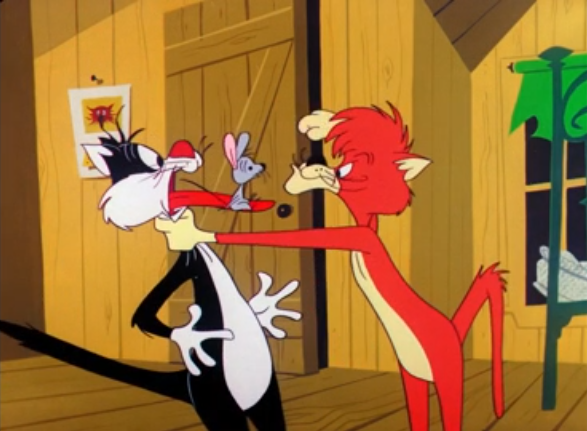
Mouse and Garden
Directed by Friz Freleng
Sylvester finds a mouse, trying to hide it from his friend Sam. Once Sam realizes this, it leads to the two endlessly fighting over the mouse, trying to prevent each other from eating the little rodent. Similar to Sam's previous appearance in "Trick or Tweet", but with the mouse replacing Tweety. I find this the stronger of the two cartoons, as the cats' personalities and their sabotaging each other are taken advantage of even more amusingly here. The mouse being a less defined character than Tweety (despite having some cute moments) also allows for more focus on the cats' antics. One of two Oscar nominations for WB cartoons this year, but both lost to Rembrandt Films' "Munro".
9
Ready, Woolen and Able
Directed by Chuck Jones
It's another day at work for Ralph Wolf and Sam Sheepdog. The wolf's attempts to catch the sheep involve a barrel of gunpowder and bed springs among others. One of my favorites in the Ralph and Sam series – as in the recent Road Runner cartoons, Jones includes an extended gag at the end where the wolf, swinging through the air, can't get away from the sheepdog no matter what he tries – the longer it goes on, the more hilarious it gets! Yet again, the crew knows how to keep things from getting stale!
10
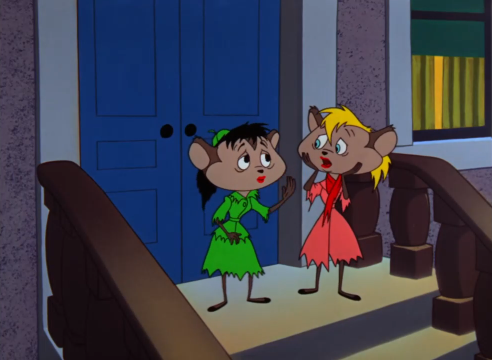
Mice Follies
Directed by Robert McKimson
Ralph and Morton have been at a lodge meeting until 2 o'clock despite promising their wives they'd be home by 11. They try to sneak in without them noticing, but they come across a cat in process, thinking the girls are angrier than ever before. The characters are once again entertaining, and their antics and misunderstandings are certainly fun to watch – and eventually the wives get in the act too! The Honey-Mousers made their last appearance here, including the only appearance of Morton's wife Trixie. Just a month after the short's release, Hanna-Barbera introduced their much more successful Honeymooners parody, The Flintstones – did McKimson and WB give up on these characters too early?
9
From Hare to Heir
Directed by Friz Freleng
Sam, Duke of Yosemite, was cut off the allowance by his uncle, the King. But just then, Bugs shows up at the door telling Sam that he has been chosen to receive a million pounds. But some money will be deducted every time he loses his temper. This proves to be a huge problem for Sam, as Bugs turns out to be a very annoying guest! A hilarious short taking full advantage of Sam's short-fused personality – we hear plenty of funny fake cursing here! A similar idea had been used in "The Wabbit Who Came to Supper" featuring Elmer back in 1942, but with Sam's temper and the refined personality of Bugs, I think this manages to be even better than that already great short was. A late classic!
10
The Dixie Fryer
Directed by Robert McKimson
Foghorn Leghorn flies south with a bunch of ducks. There he meets two hungry chickenhawks, Pappy and Elvis, and has to outwit them in order not to be eaten. The two buzzards from "Backwoods Bunny" returned here, though they're now portrayed as chickenhawks instead. Some fun moments with the characters here – all three are entertaining with their distinctly Southern mannerisms (though Foghorn is referred to as being from the North here!) and they take turns in outsmarting each other. Apart from a couple of gags, I don't find it a standout in the Foghorn series, though – just an average, entertaining effort.
8.5
Hopalong Casualty
Directed by Chuck Jones
The Road Runner (Speedipus-rex) is chased by Wile E. Coyote (Hard-headipus ravenus) who uses dynamite, a Christmas package machine and earthquake pills in his disastrous attempts. The coyote comes oh so close to catching the Road Runner at the start, but it's all downhill from there. This has another extended gag at the end, possibly my favorite in all the Road Runner cartoons! The earthquake pills scene is hilarious – the coyote's animation, his gestures, the sound effects, all of it contributes to one of the liveliest and funniest cartoon scenes I've seen. But that's not to say the other scenes aren't entertaining too. A shining moment in the series!
10
Trip for Tat
Directed by Friz Freleng
Tweety and Granny travel around the world, with Sylvester sneaking along on the ship. The cat attempts to catch the bird in each destination, but all the attempts are equally unsuccessful. Some of the destinations contain reused animation (reshot over new backgrounds) and gags from earlier cartoons. While the recycling from the likes of "Tweety's S.O.S." is quite obvious, the new scenes are genuinely funny and charming, especially the scene with Granny and Tweety painting. It also differs from the recent cheater cartoons by genuinely attempting to incorporate the reused animation into a new story instead of having characters recount past events. With just a little more new footage, this could have been a true series highlight.
9
Dog Gone People
Directed by Robert McKimson
Elmer promises his boss Mr. Crabtree to take care of his dog Rupert. But there's a problem: the dog thinks he's a human and is offended if he's treated like a dog. Elmer tries his best to comply, as he might become vice-president if he succeeds... but there's a possibility he'll be demoted, too! Chaos inevitably ensues. An interesting idea for a cartoon – the cast of characters is fun, and Rupert provides for plenty of wackiness especially after he finds a bottle of bay rum... Hal Smith takes over as the voice of Elmer Fudd here. He doesn't quite match the charm of Arthur Q. Bryan's performance (especially the character's trademark laugh sounds a little off), though his attempt is certainly better than Dave Barry's in "Pre-Hysterical Hare".
8.5
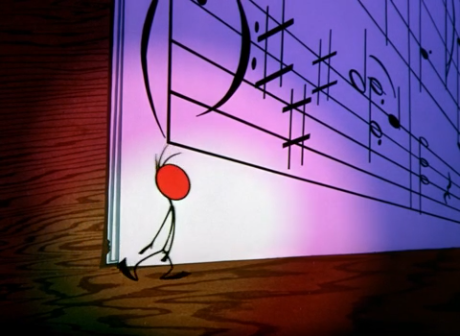
High Note
Directed by Chuck Jones
A group of musical notes is constructing the sheet music for "Blue Danube", getting ready for a performance of the composition. But things get disrupted, as one of the notes is missing, having got drunk. Can the conductor note get through the performance? An unusual cartoon with its clever and funny use of animated musical notes. I especially like how other music is used here – the note gets drunk by entering another sheet ("Little Brown Jug"), and that song's melody is heard at the appropriate moments. Definitely an imaginative one! WB's other Oscar nominee of the year. The Academy was often showing a more eccentric taste in their selections at this point, so I'm not surprised this appealed to them!
9.5
Lighter than Hare
Directed by Friz Freleng
Yosemite Sam of Outer Space tries to capture an Earth creature to take to his leader. But he picks the wrong creature, namely Bugs Bunny. After Bugs easily destroys Sam's robots, he tries to take on the rabbit himself, but he's no match for Bugs' cleverness and use of war surplus stuff. While an alien is definitely the weirdest role Sam has been in so far, I think this cartoon is a good one, with Bugs' use of the various gadgets being the standout here. We get many robot-related gags along the way. Sam's portrayal could be considered a slight weakness in this short – I don't think his typical personality traits really pop out here, so a different and more fitting alien character could very well have been used...
9
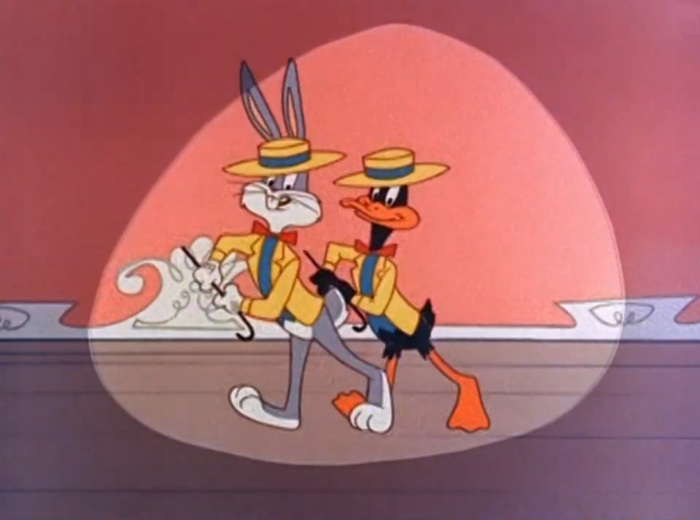
For years, movie studios had been against showing their theatrical content on television. The first Warner Bros. cartoons to appear on TV had been the pre-1948 ones sold to Guild Films and A.A.P. But by this time, the tide had turned. WB created a new show to broadcast their post-1948 library of cartoons. "The Bugs Bunny Show", aired on ABC, featured three previously released cartoon shorts in each episode, but Jones, Freleng and McKimson also directed new content for the series, with the former two also writing and producing. Between the shorts, there would be comedic segments hosted by Bugs and other characters on stage. A new theme song, "This Is It", written by Jerry Livingston and Mack David, was sung by Bugs and Daffy at the start of each show, and versions of it would be used in Looney Tunes TV broadcasts for several decades.
As influential as the show was, the original episodes of "The Bugs Bunny Show" are unfortunately very difficult to find – only a few have been released on DVD or made available by collectors. As I've already reviewed the cartoon shorts, I'll focus on the new bridging sequences here. I was able to find three episodes out of the twelve broadcast this year.
Episode 2
Directed by Friz Freleng & Chuck Jones
Co-director: Hawley Pratt
Bugs thanks the audience for watching his show and also the sponsors for spending a fortune on it. Rocky and Mugsy happen to be watching this on TV and decide to go into the television business by taking over Bugs' show. Rocky hosts (threatening the audience, the performing characters, the sponsors and even the animators in process) and tells Mugsy to "let Bugs have it". Eventually Bugs comes up with a way to outwit the gangsters. The crew is doing a very good job making these new sequences entertaining – besides the great animation, we get the usual cleverness from Bugs, but the star for me here is Rocky, with his always amusing tough guy act. The gangster even threatening the sponsors was unexpected!
9.5
Episode 5
Directed by Friz Freleng & Chuck Jones
Bugs keeps introducing all of his co-stars, apart from Daffy. The duck tries his best to steal the show, but nothing works out for him. Pepé Le Pew also shows up, stinking up the stage. Some amusing interaction between the characters here, but not quite as strong as episode 5 was. Maybe the most significant thing here is the first time Daffy interacts with Speedy Gonzales – a pairing that would later become somewhat infamous!
8.5
Episode 10
Directed by Friz Freleng & Chuck Jones
Co-director: Hawley Pratt
Daffy gets an opportunity to host The Bugs Bunny Show, but his act is interrupted by Yosemite Sam who wants to see cartoons. Eventually Daffy asks Bugs to get rid of the heckler. This feels even more like bridging sequences than the previous episodes did, with more overt references to the cartoons being shown, but it's still an enjoyable watch. Sam in particular gets to shine with his antics, though Daffy and Bugs are also great in their roles.
8.5
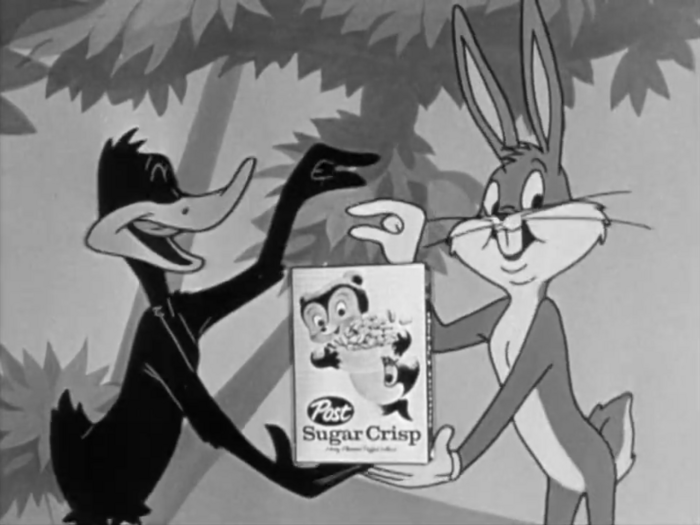
Bugs Bunny's TV appearances made him even more popular, and advertisers would take advantage of this. Especially General Foods, sponsor of "The Bugs Bunny Show", used the Looney Tunes characters to advertise their products: Post cereal and the drink Tang. While it isn't known exactly how many of these ads were made, I've seen several of them. The commercials naturally starred Bugs, with some of them also featuring Daffy, Elmer or Sam. For commercials, they were very appealing – the usual good animation, the lovable characters with Mel Blanc's inimitable voice, and a catchy jingle that appeared in many of the Post ads. This started a trend, as the characters would be used to advertise countless different products over the decades.
As in the previous two years, a Bell System science special was broadcast with cartoon sequences included, this time directed by Robert P. McKimson.
The Thread of Life
In this special going through how genetics work, animated sequences are used to showcase how height is inherited (with a comparison to tall and short trees), how chromosomes work, and DNA. Once again, the animation is there to assist the narration, but from an artistic point of view, it's less interesting than in the last two Bell specials. Most of the animation (which there isn't as much of this time) consists of rather simple geometric shapes moving around, the most notable exception being a stylized animation of a girl and a boy in the chromosome part. The earlier ones did a better job keeping things entertaining.
7
The WB cartoons' last decade is off to a nice start. A solid run of the theatrical shorts with a few brilliant efforts in the bunch (especially those by Chuck Jones). The cartoons' TV debut with "The Bugs Bunny Show" was also a charming one based on the footage that can be found – and this series definitely played a big part in the characters achieving their enduring popularity.
-
 1
1
-
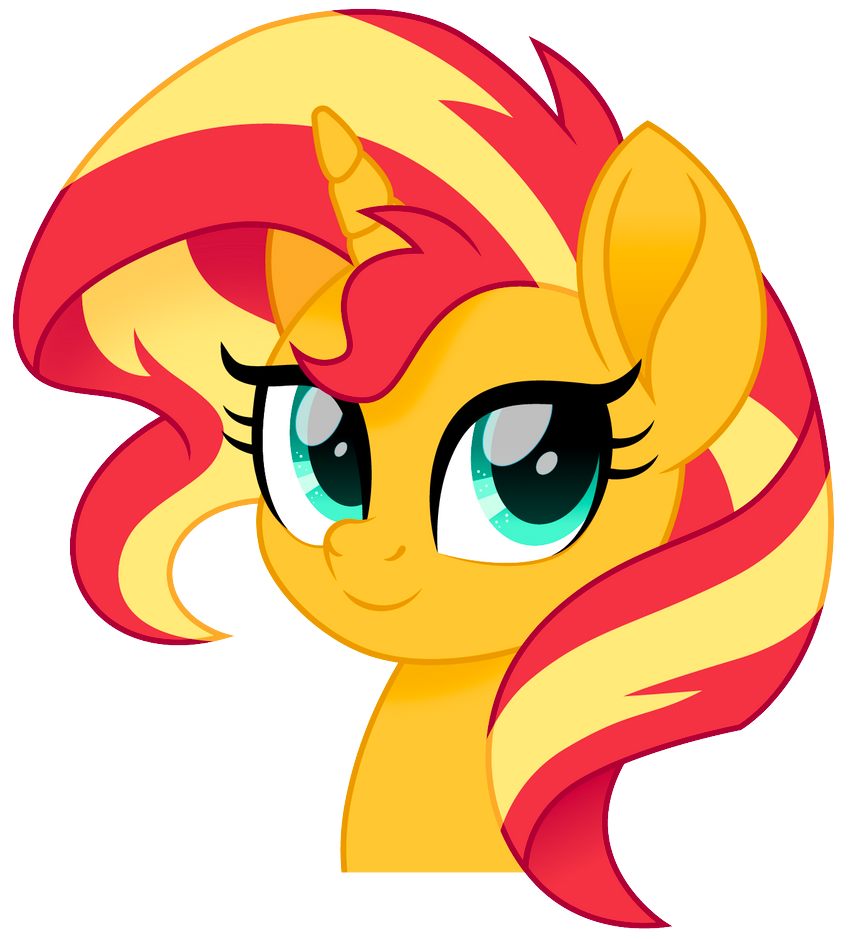 1
1



2 Comments
Recommended Comments
Create an account or sign in to comment
You need to be a member in order to leave a comment
Create an account
Sign up for a new account in our community. It's easy!
Join the herd!Sign in
Already have an account? Sign in here.
Sign In Now